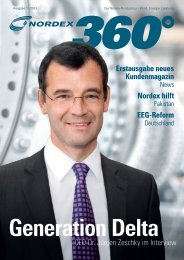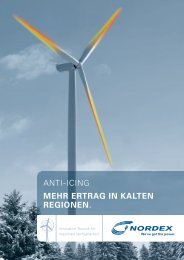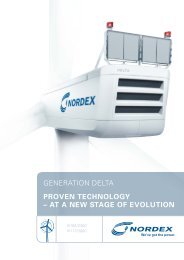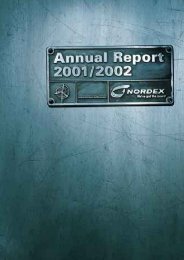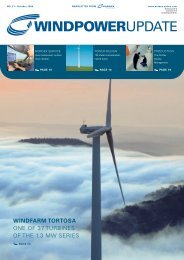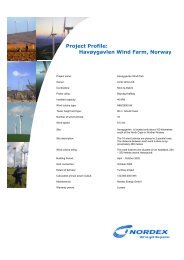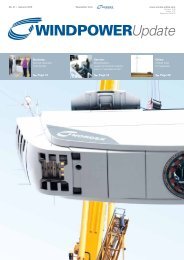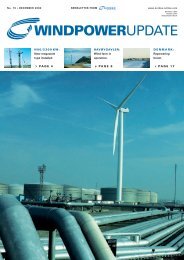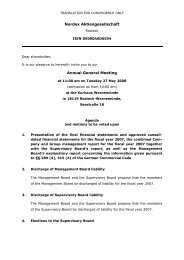OFFERING MEMORANDUM Global Offering of up to ... - Nordex
OFFERING MEMORANDUM Global Offering of up to ... - Nordex
OFFERING MEMORANDUM Global Offering of up to ... - Nordex
Create successful ePaper yourself
Turn your PDF publications into a flip-book with our unique Google optimized e-Paper software.
Since Taifun AG will not commence with its operations before early 2001 and its subsidiaries will until<br />
then remain fully integrated at the organizational level with Borsig Energy GmbH or the BDAG Balcke-<br />
Dürr AG Gro<strong>up</strong>, no effective gro<strong>up</strong> structure in terms <strong>of</strong> a control <strong>of</strong> the contributed subsidiaries<br />
existed in 2000 despite the agreements consummated in November/December 2000.<br />
This is why capital consolidation has been waived when preparing the (combined) pro forma<br />
consolidated financial statements for the fiscal years ended September 30, 1998, September 30, 1999,<br />
and September 30, 2000; instead, the equity <strong>of</strong> the subsidiaries has been merely footed <strong>up</strong>. For the<br />
same reason, no pro forma goodwill amortization has been shown either.<br />
Another reason for the nonrecognition <strong>of</strong> pro forma goodwill amortization or pro forma releases <strong>of</strong><br />
badwill from capital consolidation in the (combined) pro forma consolidated financial statements is<br />
that the relevant amounts required <strong>to</strong> determine goodwill or badwill could not be reliably measured<br />
when preparing the financial statements (IASC Framework paragraphs 86 et seq. in conjunction with<br />
par. 83). This refers <strong>to</strong> the shares in Taifun AG’s subsidiaries, which the provisions <strong>of</strong> IAS 22.21 et seq.<br />
require <strong>to</strong> be recognized at cost and which, after having been transferred as agreed at book value by<br />
Borsig Energy GmbH and Nordvest A/S <strong>to</strong> Taifun AG, would have had <strong>to</strong> be <strong>of</strong>fset against the IAS equity<br />
<strong>of</strong> such subsidiaries. The relevant equity (early 2001) was not determinable when the financial<br />
information was prepared.<br />
The expected future goodwill amortization will adversely affect performance in future consolidated<br />
financial statements. In consolidation, all receivables and payables among consolidated subsidiaries<br />
were mutually <strong>of</strong>fset, without producing any exchange gains or losses.<br />
The aggregate <strong>to</strong>tal <strong>of</strong> kE27.4 (net balance) (<strong>up</strong> from kE10.2 in 1998/99) representing (i) intercompany<br />
pr<strong>of</strong>its which in fiscal 1999/2000 were made from intragro<strong>up</strong> transfers within inven<strong>to</strong>ries, as well as (ii)<br />
the prorated pr<strong>of</strong>its realized according <strong>to</strong> the percentage-<strong>of</strong>-completion method, was eliminated in<br />
consolidation. The accounting for capital leases according <strong>to</strong> IAS 17 (from the gro<strong>up</strong>’s vantage point)<br />
resulted in fiscal 1999/2000 in income <strong>of</strong> kE247.3 (<strong>up</strong> from kE56.2 in 1998/99). Consequently,<br />
consolidation transactions in fiscal 1999/2000 raised income (including the allocable deferred taxes) by<br />
kE130.9 (<strong>up</strong> from kE27.1 in 1998/1999).<br />
Moreover, all expenses and income originating from intragro<strong>up</strong> transfers <strong>of</strong> goods/services and from<br />
intercompany allocations were mutually netted in consolidation.<br />
In addition, the gro<strong>up</strong> fees apportioned and charged in the periods under review were in consolidation<br />
eliminated from net income and replaced by imputed future personnel and administrative expenses <strong>of</strong><br />
Taifun AG, duly accounting for the imputed tax effects, cf. Note (1).<br />
(4) General accounting and valuation details<br />
(4.1) Classification<br />
The classification rules <strong>of</strong> Art. 266 HGB (after adjustment <strong>to</strong> specific IAS disclosure requirements) were<br />
applied for preparing the IAS-based balance sheets. The income statements according <strong>to</strong> IAS are<br />
presented in the full-cost format in analogy <strong>to</strong> the classification provisions <strong>of</strong> Art. 275(2) HGB. Major<br />
deviations from the HGB-oriented disclosure format are, in particular, attributable <strong>to</strong> the derivation<br />
from IAS-based net income <strong>of</strong> pro forma net earnings, cf. Note (1).<br />
(4.2) Details <strong>of</strong> accounting and valuation methods<br />
Within intangible assets, mainly purchased licenses and s<strong>of</strong>tware were capitalized. Internally created<br />
intangible assets (i.e., pro<strong>to</strong>type development costs) were capitalized whenever permitted by IAS 38.<br />
Intangible assets and property, plant & equipment were stated at cost and, where applicable, amortized<br />
or depreciated systematically on a straight-line basis over the anticipated useful lives <strong>of</strong> the underlying<br />
assets. For additions <strong>to</strong> personal property (plant & equipment) in the first half <strong>of</strong> the fiscal year, the full<br />
annual depreciation rate was applied while for additions in the second 6-month period, half this annual<br />
rate was used. Low-value assets (under German law, valued at net cost <strong>of</strong> E409 or less each) were full<br />
F-13



